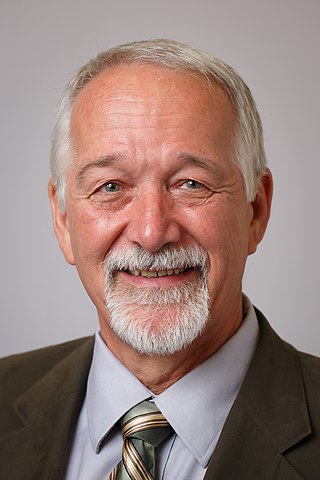Related Research Articles
Quadratic programming (QP) is the process of solving certain mathematical optimization problems involving quadratic functions. Specifically, one seeks to optimize a multivariate quadratic function subject to linear constraints on the variables. Quadratic programming is a type of nonlinear programming.

Mathematical optimization or mathematical programming is the selection of a best element, with regard to some criteria, from some set of available alternatives. It is generally divided into two subfields: discrete optimization and continuous optimization. Optimization problems arise in all quantitative disciplines from computer science and engineering to operations research and economics, and the development of solution methods has been of interest in mathematics for centuries.
In mathematical optimization theory, the linear complementarity problem (LCP) arises frequently in computational mechanics and encompasses the well-known quadratic programming as a special case. It was proposed by Cottle and Dantzig in 1968.
Convex optimization is a subfield of mathematical optimization that studies the problem of minimizing convex functions over convex sets. Many classes of convex optimization problems admit polynomial-time algorithms, whereas mathematical optimization is in general NP-hard.
In mathematical optimization, a trust region is the subset of the region of the objective function that is approximated using a model function. If an adequate model of the objective function is found within the trust region, then the region is expanded; conversely, if the approximation is poor, then the region is contracted.
The Frank–Wolfe algorithm is an iterative first-order optimization algorithm for constrained convex optimization. Also known as the conditional gradient method, reduced gradient algorithm and the convex combination algorithm, the method was originally proposed by Marguerite Frank and Philip Wolfe in 1956. In each iteration, the Frank–Wolfe algorithm considers a linear approximation of the objective function, and moves towards a minimizer of this linear function.
Karmarkar's algorithm is an algorithm introduced by Narendra Karmarkar in 1984 for solving linear programming problems. It was the first reasonably efficient algorithm that solves these problems in polynomial time. The ellipsoid method is also polynomial time but proved to be inefficient in practice.
The TOMLAB Optimization Environment is a modeling platform for solving applied optimization problems in MATLAB.
Hydrological optimization applies mathematical optimization techniques to water-related problems. These problems may be for surface water, groundwater, or the combination. The work is interdisciplinary, and may be done by hydrologists, civil engineers, environmental engineers, and operations researchers.

Jenő Elek Egerváry was a Hungarian mathematician.

Portfolio optimization is the process of selecting an optimal portfolio, out of a set of considered portfolios, according to some objective. The objective typically maximizes factors such as expected return, and minimizes costs like financial risk, resulting in a multi-objective optimization problem. Factors being considered may range from tangible to intangible.
Robert J. Vanderbei is an American mathematician and Emeritus Professor in the Department of Operations Research and Financial Engineering at Princeton University.

In mathematical optimization, the criss-cross algorithm is any of a family of algorithms for linear programming. Variants of the criss-cross algorithm also solve more general problems with linear inequality constraints and nonlinear objective functions; there are criss-cross algorithms for linear-fractional programming problems, quadratic-programming problems, and linear complementarity problems.
Philip Starr "Phil" Wolfe was an American mathematician and one of the founders of convex optimization theory and mathematical programming.
Parametric programming is a type of mathematical optimization, where the optimization problem is solved as a function of one or multiple parameters. Developed in parallel to sensitivity analysis, its earliest mention can be found in a thesis from 1952. Since then, there have been considerable developments for the cases of multiple parameters, presence of integer variables as well as nonlinearities.

Carlton Edward Lemke was an American mathematician.
The quadratic knapsack problem (QKP), first introduced in 19th century, is an extension of knapsack problem that allows for quadratic terms in the objective function: Given a set of items, each with a weight, a value, and an extra profit that can be earned if two items are selected, determine the number of items to include in a collection without exceeding capacity of the knapsack, so as to maximize the overall profit. Usually, quadratic knapsack problems come with a restriction on the number of copies of each kind of item: either 0, or 1. This special type of QKP forms the 0-1 quadratic knapsack problem, which was first discussed by Gallo et al. The 0-1 quadratic knapsack problem is a variation of the knapsack problem, combining the features of the 0-1 knapsack problem and the quadratic knapsack problem.

Richard W. Cottle is an American mathematician. He was a professor of Management Science and Engineering at Stanford University, starting as an Acting Assistant Professor of Industrial Engineering in 1966 and retiring in 2005. He is notable for his work on mathematical programming/optimization, “Nonlinear programs”, the proposal of the linear complementarity problem, and the general field of operations research.

Tamás Terlaky is a Hungarian-Canadian-American professor of Industrial and Systems Engineering at Lehigh University. He is especially well known for his work on criss-cross algorithms, interior-point methods, Klee-Minty examples for path following algorithms, and optimization.
James Milton Renegar Jr. is an American mathematician, specializing in optimization algorithms for linear programming and nonlinear programming.
References
- 1 2 Albert-Goldberg, Nancy (2005). A3 & His Algebra: How a Boy from Chicago's West Side Became a Force in American Mathematics. iUniverse. p. 348. ISBN 9781469726397.
- 1 2 "Marguerite Josephine Straus Frank". Mathematics Genealogy Project. Retrieved 2017-03-06.
- ↑ Assad, Arjang A; Gass, Saul I (2011). Profiles in operations research: pioneers and innovators. Boston, MA: Springer Science+Business Media. ISBN 9781441962812.
- ↑ Frank, M.; Wolfe, P. (1956). "An algorithm for quadratic programming". Naval Research Logistics Quarterly. 3 (1–2): 95–110. doi:10.1002/nav.3800030109.
- ↑ "Joseph Frank, Biographer of Dostoevsky, Dies at 94". New York Times . 4 March 2013. Retrieved 13 March 2014.